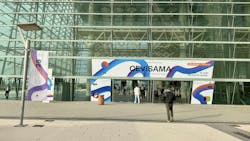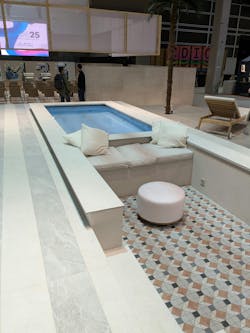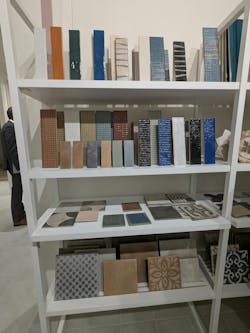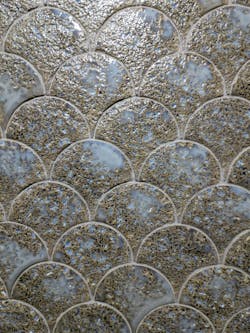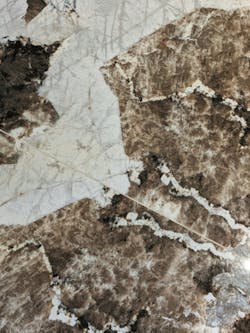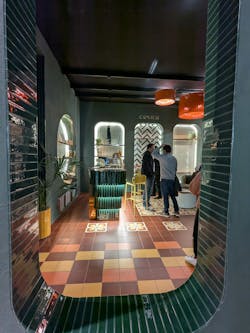Spanish Tile Industry Trends and Innovations at Cevisama 2025
Our 2025 exhibition coverage began with a burst of biomaterial innovation at Germany’s Heimtextil in January, and continued with an exploration of all things ceramic at Spain’s Cevisama, the International Tile & Bath Furnishing Show, in February.
During a multi-day “Passport to Creativity” trip hosted by Tile of Spain USA, i+s found plenty of inspiration that went far beyond the surface. Tile of Spain is an international brand representing more than 100 ASCER (Spanish Ceramic Tile Manufacturers’ Association) member companies. The annual Tile of Spain trip brings together a group of interior design, architecture, and media professionals to look behind the scenes at the famed Spanish tile manufacturers in Castellón; discover inspiration in the architecture, history, and cultural influences at play in Valencia; and connect those experiences with the displays from Tile of Spain vendors on the floor at Feria Valencia during Cevisama.
Market Trend Dynamics
On February 25th, visitors learned firsthand from ASCER president Vicente Nomdedeu that the Spanish tile market is deemed in a recovery period from the economic impacts of the COVID-19 pandemic, with total sales of $5.2 billion for 2024. Domestic sales grew by 3.1% and employment grew by 5.7% compared to 2023.
In spite of a 2.4% drop over the previous year’s tile exports, production and demand remain strong, according to ASCER’s data. The United States remains the leading export destination for Spanish tiles, with $510 million in sales for 2024.
Still, press conference attendees were curious as to how other events factored in to supply-chain disruption and market shifts. In particular, journalist Elizabeth Fazzare for AN Interior asked how the ongoing war between Ukraine and Russia has affected the supply of white clay used abundantly in finished tile products.
ASCER representatives explained that the Spanish tile industry has sought new sources of white clay to address supply bottlenecks from Ukraine over the past several years. As a result, manufacturers have adopted sources from Romania, the United Kingdom, and Spain, as well as India and South Africa, establishing new supply relationships. Although this necessitated some reformulation of product that slowed manufacturing for a period of time, tile fabricators were able to adapt to the raw material changes and scale up to meet demand, they said.
Partners from Observatorio de Tendencias del Hábitat (the Habitat Trends Observatory) summarized the outlook for Spanish ceramic tile based on emerging design trends and evolving needs of the interior design community.
For example, Observatory speakers said, because of their durability, adaptability, textures, and finishes, ceramics can enable continuity between interior and exterior spaces that can be difficult to achieve with a mix of materials, such as wood, composites, and natural stone, which require very different installation methods and more thoughtful transitions from one floor to the next. Furthermore, ceramic tile and large-format porcelain slab are increasingly being used in novel ways: as wall surfaces, countertops/task areas, and on furniture.
Rather than rehashing the past, the trend forecasters observed, Tile of Spain members are focusing on using historic style preferences and trends as a launchpad for new design concepts, such as reinterpreting traditional emblems and motifs, utilizing terrazzo in smaller parts to simulate a mosaic effect. Both standard and large-format manufacturers are also releasing products that mimic the look of smaller-format tile designs—with “penny tile” styles, grout lines, and other pattern or material looks side by side. As a clever solution, such larger-format styles can be installed more efficiently, more economically, and to achieve a smoother flow from one space to the next.
Making an Impression
Two days were spent on the floor at Feria Valencia and one day in between was dedicated to Tile of Spain manufacturer showrooms and factories. Following are five key themes that we observed throughout the products and exhibits, which support the overarching Spanish tile industry trends that the ASCER and Observatory representatives shared during their press conference.
Tradition with a Twist. Hotel Cevisama, a curated hospitality installation of around 800 square meters, intrigued visitors with its modern sensibility that demonstrated both the traditional and transitional features of ceramic to unify individual and communal spaces. A team led by architect Héctor Ruiz-Velázquez combined the biophilic design qualities enabled by ceramic—like the natural hues and variations of stone—with innovations such as nanoparticulates utilized in the stuccoed clay wall surfaces to help mitigate bacteria in the space without requiring ultraviolet technology for activation. The patio, tiled at different levels with wood- and stone-look surfaces featuring anti-slip texture, incorporated a beautiful geometric motif in a “dry” lounge next to the sample pool with a botanical accent trim.
Beautiful Impostors. As seen at Cevisama and in the factory showrooms, tile manufacturers continue to draw inspiration from the natural world, with many products on display able to fool the viewer into mistaking them for mineral-veined marble, luxurious limestone, refined slate, and even hardwood or wood-composite surfaces.
By the Sea. In Mediterranean Sea-inspired shades of aquamarine, sea-glass green, cerulean, and even a murkier teal that evoke the ocean depths; a multitude of finishes along the spectrum from matte to glossy; and a variety of sizes and formats, tile was shown in a range of classic poolside and patio settings. Bold emerald green made an appearance as well in an elevated, Bohemian chic exhibit—called “Night Fever”—by relative newcomer Cevica, which works directly with architecture and design pros to curate more custom, small-format tile solutions.
Nuanced Neutrals. Tile of Spain USA product development consultant Ryan Fasan noted that trip guests would naturally see a multitude of neutral tile, given the lifetime of the product and the desire for interiors that can stand the test of time, particularly in high-traffic or high-turnover environments such as hospitality. Yet “neutral” turned out to include a wealth of nuance. Understated but never dull, details included mindful gradations in shading over a range of creamy white, sand, and tan; added texture, relief, or embossing; a plethora of finish options; and a return to the charming and rustic look of terracotta.
Differentiation Through Details. As mentioned within the context of neutrals, embossing and texture paraded throughout the Cevisama stands and Tile of Spain showroom floors. An enormous variety of unusual shapes proved their worth in creating gorgeous patterns that would deliver wall interest and a distinct cool factor in hospitality or branded commercial, retail, or entertainment venues. Extrusion also produced unique form factors, such as tubular ceramics, while botanical, geometric, and linear patterns reigned everywhere. From reactive glazes to brilliant colors, there was something to excite every design mind.
The Spanish tile industry may draw from a long history of traditional motifs, color schemes, and cultural inspiration, but it remains adaptable, evolving to meet contemporary functional and aesthetic demands through modern fabrication techniques.
